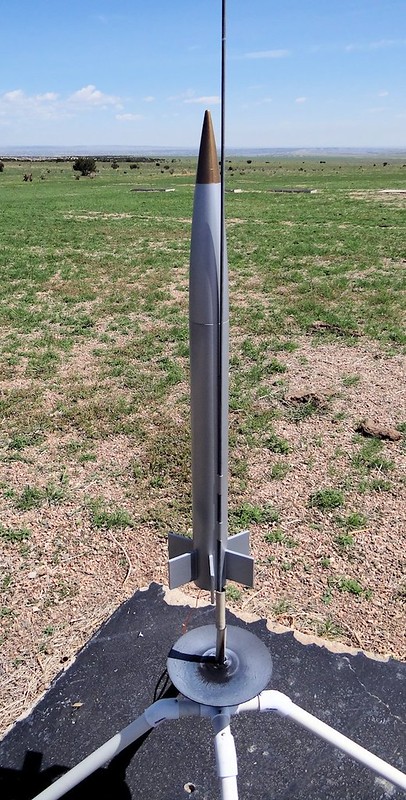The test rocket design is as shown and photographed. Measured mass and CG override was used. Actual launch altitude and weather conditions were used in both Rocksim (RS) and Openrocket (OR) simulations. Ambient temperature was 63 F.
Motor used was an Aerotech E20W-7 single use. In 10 E20 NAR certification samples: Total Impulse spec 35 N-s; measured average 35.01 N-s; Std Dev % only 0.8%!
NAR-reported standard deviation % for Max Thrust, Avg. Thrust, and Burn Time were 2.6%, 1.8%, and 1.7% respectively
Any delay time error in the motor used is irrelevant to the maximum altitude actually achieved since deployment was post-apogee.
So, in all respects, the single motor used can most likely be considered to be in more than adequate compliance with the motor data used by both RS and OR. Anyway, good enough to get a ballpark comparison of RS and OR predictions versus measured results.
A second flight data acquisition attempt was to use an F32T-8, but it became too windy for optimum vertical ascent due to weathercocking. Only minor weathercocking was observed during the E20W-7 flight. The F32T-8 flight will be done at some near-term future date followed by another E20W-7 and F32T-8 flight to acquire more data points.
Note that this square fin leading edge test rocket was designed to be an
extreme example with its six thick, unswept, and flat leading edges. I'll leave it to others to test the square vs rounded/streamlined leading edge simulation differences versus measured results between RS and OR for less extreme, far more typical examples with fewer and swept fins.
Results with Aerotech single use
E20W-7, only the most important values for rocket survival using motor delay train deployment method listed:
Apogee
------
1137 ft - Rocksim (145% of measured)
713 ft - Openrocket (91% of measured)
783 ft - Measured (by Altimeter II v2)
Deployment Velocity
-------------------
19 ft/s down - Rocksim
58 ft/s down - Openrocket
48 ft/s down - Calculated from the measured apogee to deployment time of 1.5s using this on-line calculator and my calculated air resistance (k) value of 0.001471 kg/m from k=0.5*rho*Cd*A assuming a Cd of 0.75:
https://keisan.casio.com/exec/system/1224830797
Given the low velocity achieved prior to deployment and the very low drag of a rocket, that complex path gives effectively the same result as the simple vacuum velocity formula v=a*t.
Descent Velocity (parachute)
16.5 ft/s - Rocksim
15.6 ft/s - Openrocket
16 ft/s - Measured
EDIT: Results with Aerotech single use
F32T-8 to conduct test at higher max velocity:
Apogee
------
1891 ft - Rocksim (162% of measured)
1065 ft - Openrocket (91% of measured)
1167 ft - Measured (by Altimeter II v2)
The Rocksim's apogee value overshot measured apogee by a greater amount (162% vs 145%) as the maximum flight velocity increased indicating that it was underestimating the increase in fin drag at higher velocities.
Openrocket's predictions remained the same (91% vs 91% of measured altitude) at both lower and higher max velocities indicating that it was properly compensating for the increased drag of the six flat leading/trailing edge fins at higher velocities.








